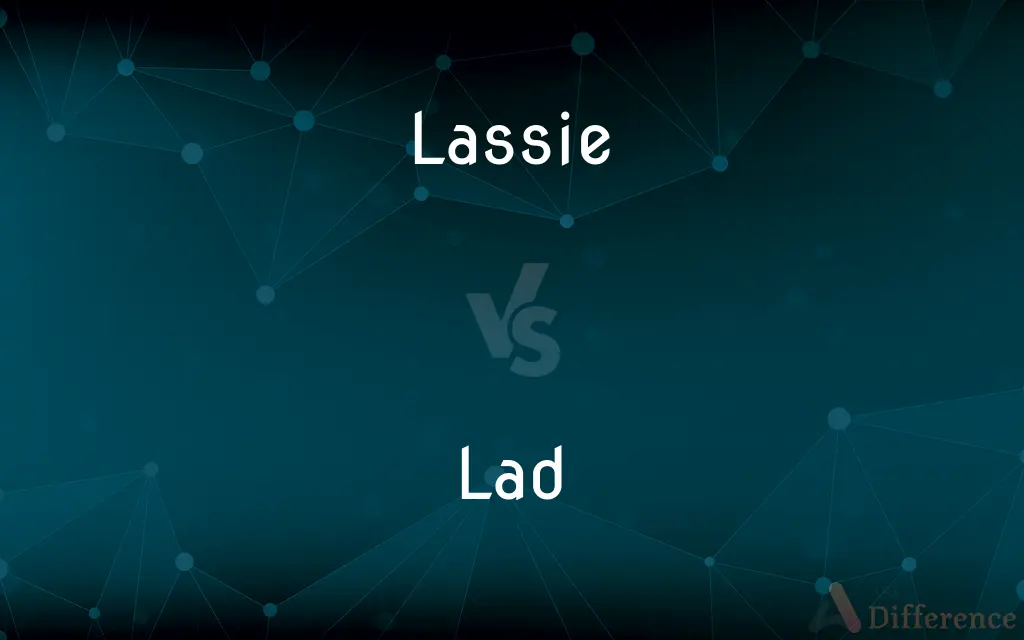Lassie vs. Lad — What's the Difference?
By Maham Liaqat & Urooj Arif — Updated on March 27, 2024
Lassie refers to a young girl or woman, often emphasizing youth and innocence, while lad denotes a young boy or man, typically conveying a sense of youthfulness and energy.

Difference Between Lassie and Lad
Table of Contents
ADVERTISEMENT
Key Differences
Lassie is a term used to describe a young girl or woman, often imbued with connotations of youth, innocence, and sometimes naivety. It's a term that evokes imagery of femininity and is commonly used in Scottish and broader British English. On the other hand, lad refers to a young boy or man, suggesting a youthful vigor, bravery, or even mischief. Like lassie, lad is deeply rooted in British English, carrying with it an air of casual familiarity.
While "lassie" is frequently used in contexts that highlight gentleness or tenderness, "lad" often finds its place in scenarios emphasizing action, energy, and sometimes rebelliousness. This distinction paints a broader cultural picture of traditional gender roles, though both terms are used affectionately in most contexts.
The use of "lassie" can be traced back to Scottish and Northern English dialects, where it was affectionately used to refer to young girls or beloved women in one's life. Conversely, "lad" has been a staple in English vernacular for centuries, often used to address young men in a range of contexts, from the affectionate to the admonishing.
In literature and media, "lassie" has often been associated with characters that embody purity, beauty, and a connection to nature, as epitomized by the famous fictional collie, Lassie. "Lad," meanwhile, frequently appears in tales of adventure, camaraderie, and the journey to manhood, emphasizing traits like courage and loyalty.
Despite their distinct connotations, both terms share a common thread of endearment and nostalgia. They evoke a simpler time or place, be it in literature, film, or everyday speech, serving as reminders of youth and its accompanying virtues and challenges.
ADVERTISEMENT
Comparison Chart
Definition
A term for a young girl or woman.
A term for a young boy or man.
Connotations
Youth, innocence, femininity.
Youthfulness, energy, bravery.
Origin
Scottish and Northern English dialects.
Broadly used in British English.
Common Usage
Affectionate, tender contexts.
Action-oriented, sometimes rebellious.
Cultural Roles
Embodies purity, beauty, nature.
Embodies courage, camaraderie, adventure.
Compare with Definitions
Lassie
A young girl or woman, particularly in Scotland.
The lassie danced through the fields with joy.
Lad
Used informally to refer to a male friend.
He's a good lad, always there when you need him.
Lassie
A term of endearment for a beloved girl.
Come here, lassie, and see what I've got for you.
Lad
A term encapsulating youthful mischief and bravery.
That lad is always up to something.
Lassie
A figure of innocence and youth in literature.
The lassie in the story symbolizes hope.
Lad
A young boy or man, often noted for his vivacity.
The lad ran ahead, eager to explore.
Lassie
A cultural icon, represented by the fictional dog, Lassie.
Lassie always finds her way home.
Lad
A member of a group of male friends or companions.
The lads gathered for their weekly football match.
Lassie
Used affectionately to refer to female lovers or friends.
He missed his lassie while at sea.
Lad
In literature, a protagonist on a journey of growth.
The young lad embarked on an adventure.
Lassie
Lassie is a fictional female Rough Collie dog, and is featured in a short story by Eric Knight that was later expanded to a full-length novel called Lassie Come-Home. Knight's portrayal of Lassie bears some features in common with another fictional female collie of the same name, featured in the British writer Elizabeth Gaskell's 1859 short story "The Half Brothers".
Lad
A boy or young man.
Lassie
A lass.
Lad
(Informal) A man of any age; a fellow.
Lassie
A young girl, a lass, especially one seen as a sweetheart.
Lad
A boy or young man.
Lassie
A young girl; a lass.
Lad
(British) A Jack the lad; a boyo.
I think he reckons he's a bit of a lad.
Last night I was out drinking with the lads.
Lassie
A girl or young woman who is unmarried
Lad
A familiar term of address for a young man.
Come here, lad, and help me shift these boxes.
Lad
A groom who works with horses.
Lad
The penis.
Lad
A boy; a youth; a stripling.
There is a lad here, which hath five barley loaves and two small fishes.
Lad
A companion; a comrade; a mate.
Lad
A boy or man;
That chap is your host
There's a fellow at the door
He's a likable cuss
Lad
A male child (a familiar term of address to a boy)
Common Curiosities
What does lad mean?
A term for a young boy or man, implying youthfulness, energy, and sometimes mischief.
What is a lassie?
A young girl or woman, often used affectionately or to denote youth and innocence.
Do lassie and lad carry any cultural significance?
Yes, both terms are imbued with cultural connotations, reflecting traditional gender roles and characteristics.
Can lassie and lad be used in formal contexts?
They are predominantly informal terms, best suited to casual conversation or literary narratives.
Are lassie and lad exclusively British terms?
While deeply rooted in British English, their use has spread globally, often through literature and media.
Can these terms be considered affectionate?
Yes, both lassie and lad are frequently used with affection and endearment.
Do lassie and lad have equivalents in other languages?
Many languages have their own terms for young people, though the cultural connotations may differ.
How does the use of lassie and lad reflect societal views?
They echo traditional views on gender roles, though their usage has evolved over time.
Are there modern equivalents to lassie and lad?
Terms like "girl" and "boy" or "young woman" and "young man" serve similar purposes in modern English, though they lack the cultural nuances.
Can adults be referred to as lassie or lad?
While less common, adults can be affectionately referred to as lassie or lad, often to evoke a sense of youthfulness.
Is the use of lassie and lad declining?
Their use may have diminished in everyday speech, but they remain vibrant in literature, media, and dialects.
How have lassie and lad been portrayed in literature and media?
Lassie often symbolizes purity and beauty, while lad represents courage and adventure.
What impact have lassie and lad had on pop culture?
Both terms have been immortalized in pop culture, notably through characters like the dog Lassie and in songs and movies celebrating youth and bravery.
How do lassie and lad contribute to a sense of identity?
They can play a role in shaping one's cultural or national identity, especially within the contexts from which they originate.
What lessons can be learned from the traditional roles of lassie and lad?
They offer insights into historical perspectives on gender and youth, inviting reflection on how these concepts have evolved.
Share Your Discovery

Previous Comparison
Carbon vs. Coal
Next Comparison
Comma vs. SemicolonAuthor Spotlight
Written by
Maham LiaqatCo-written by
Urooj ArifUrooj is a skilled content writer at Ask Difference, known for her exceptional ability to simplify complex topics into engaging and informative content. With a passion for research and a flair for clear, concise writing, she consistently delivers articles that resonate with our diverse audience.
















































